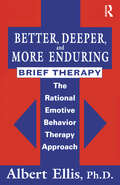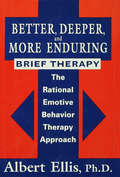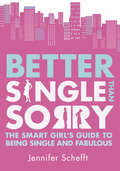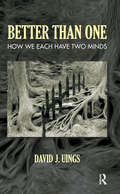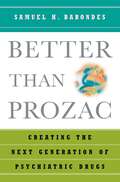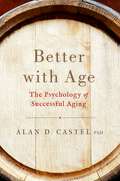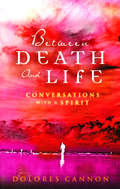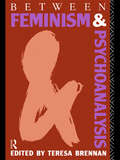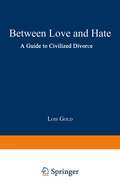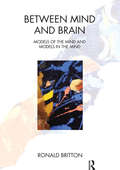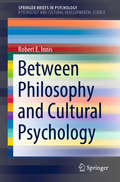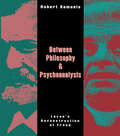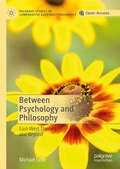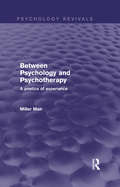- Table View
- List View
Better But Not Well: Mental Health Policy in the United States since 1950
by Richard G. Frank Sherry A. GliedThe past half-century has been marked by major changes in the treatment of mental illness: important advances in understanding mental illnesses, increases in spending on mental health care and support of people with mental illnesses, and the availability of new medications that are easier for the patient to tolerate. Although these changes have made things better for those who have mental illness, they are not quite enough. In Better But Not Well, Richard G. Frank and Sherry A. Glied examine the well-being of people with mental illness in the United States over the past fifty years, addressing issues such as economics, treatment, standards of living, rights, and stigma. Marshaling a range of new empirical evidence, they first argue that people with mental illness—severe and persistent disorders as well as less serious mental health conditions—are faring better today than in the past. Improvements have come about for unheralded and unexpected reasons. Rather than being a result of more effective mental health treatments, progress has come from the growth of private health insurance and of mainstream social programs—such as Medicaid, Supplemental Security Income, housing vouchers, and food stamps—and the development of new treatments that are easier for patients to tolerate and for physicians to manage. The authors remind us that, despite the progress that has been made, this disadvantaged group remains worse off than most others in society. The "mainstreaming" of persons with mental illness has left a policy void, where governmental institutions responsible for meeting the needs of mental health patients lack resources and programmatic authority. To fill this void, Frank and Glied suggest that institutional resources be applied systematically and routinely to examine and address how federal and state programs affect the well-being of people with mental illness.
Better, Deeper And More Enduring Brief Therapy: The Rational Emotive Behavior Therapy Approach
by Albert EllisFirst published in 1996. Routledge is an imprint of Taylor & Francis, an informa company.
Better, Deeper And More Enduring Brief Therapy: The Rational Emotive Behavior Therapy Approach
by Albert EllisFirst published in 1996. Routledge is an imprint of Taylor & Francis, an informa company.
Better Late than Never: The Reparative Therapeutic Relationship in Regression to Dependence
by Lorraine PriceThis book is concerned with an enigmatic set of experiences which theorists in the Object Relations tradition have characterised as regression to dependence, a return to a primitive, pre-verbal relational process presenting in some clients in psychotherapy. It highlights the effects of early infantile trauma resulting in the experience of failed dependency. Clients who present with chronic anxiety, relational failures and an inner emptiness are considered, and the opportunity for a therapeutic repair is explored with recommendations for the therapeutic stance being made. Written from an Integrative Psychotherapy perspective, it addresses the current absence of writing in the field from a relational / developmental viewpoint on concepts more usually addressed in psychoanalytic writing. The insights of Winnicott are particularly highlighted in relation to failed dependency and maternal failure. This work aims to offer a way forward to successfully work with this client group.
Better Late than Never: The Reparative Therapeutic Relationship in Regression to Dependence
by Lorraine PriceThis book is concerned with an enigmatic set of experiences which theorists in the Object Relations tradition have characterised as regression to dependence, a return to a primitive, pre-verbal relational process presenting in some clients in psychotherapy. It highlights the effects of early infantile trauma resulting in the experience of failed dependency. Clients who present with chronic anxiety, relational failures and an inner emptiness are considered, and the opportunity for a therapeutic repair is explored with recommendations for the therapeutic stance being made. Written from an Integrative Psychotherapy perspective, it addresses the current absence of writing in the field from a relational / developmental viewpoint on concepts more usually addressed in psychoanalytic writing. The insights of Winnicott are particularly highlighted in relation to failed dependency and maternal failure. This work aims to offer a way forward to successfully work with this client group.
Better Living With Dementia: Implications for Individuals, Families, Communities, and Societies
by Laura N. Gitlin Nancy A. HodgsonBetter Living With Dementia: Implications for Individuals, Families, Communities, and Societies highlights evidence-based best practices for improving the lives of patients with dementia. It presents the local and global challenges of these patients, also coupling foundational knowledge with specific strategies to overcome these challenges. The book examines the trajectory of the disease, offers stage-appropriate practices and strategies to improve quality of life, provides theoretical and practical frameworks that inform on ways to support and care for individuals living with dementia, includes evidence-based recommendations for research, and details global examples of care approaches that work.Weaves research evidence and theories with practical know-howIdentifies support strategies for home, community, and health care settingsProvides stage-appropriate strategies relative to dementia severitySummarizes dementia pathology, diagnosis, and progressionConsiders the changing needs of both the individual with dementia and family and formal caregiversOffers evidence-informed recommendations for research, practice, policy, and how to make things better at home, in the community, in healthcare and service settings, and through national policiesProvides local and global exemplars of what worksProvides case vignettes to illustrate key points with real examplesContains brief conversations with national and international experts
Better Single Than Sorry
by Jennifer Schefft'It's time for women to start telling the world - and each other - why it's better to be single than sorry. Yes, it's great to have a boyfriend or a husband, and I'm not suggesting women give up the idea of happily ever after, but I don't believe in settling... The truth is, we know what we're looking for and we must never sell ourselves short.'Life can be fabulous on your own - the antidote to dating books!Better Single than Sorry has a simple, refreshing and powerful message. It's far better to be single than to end up with someone who doesn't make you happy just because you want to be in a couple, feel pressured by society / your friends / your mother, or you want to get married or have kids. She's all for compromising and being realistic, but she encourages women not to settle for the sake of it. Chapters include: - Being Single is Not a Curse- It Takes Guts to be On your Own- Don't Play Hard to Get - Be Hard to Get- 50 Reasons Why it's Great to be Single- But All My Friends are Married...- Stop Believing You Can't do Better- Throw Away the Picture of your Ideal Man- Don't Talk yourself into Liking a Guy- Basic Instinct - Trust Yours- What you Want Versus what you Need
Better Than One: How We Each Have Two Minds
by David J. UingsStarting with research by Nobel laureate Roger Sperry into split-brain patients, this book sets out the evidence that there is a conscious mind in each hemisphere of the human brain. Two forms of consciousness are distinguished, and the difference in the consciousness of each mind revealed. The two different pathways within the human visual system and their effect on human behaviour are described, as well as differences in the memories formed by each mind. Evidence for two minds in the intact human brain is analysed, including psychological experiments and every-day experiences such as sleep-walking and driving on "automatic pilot". Reasons are suggested to explain why the evidence from split-brain patients has been largely ignored, and the views of six authors who have addressed the issue are considered. The presence of two minds - each with its own memories, thoughts, desires, and decisions that are inaccessible to the other - has important implications for all those whose work involves the mind, including psychologists, psycho-therapists and lawyers.
Better Than One: How We Each Have Two Minds
by David J. UingsStarting with research by Nobel laureate Roger Sperry into split-brain patients, this book sets out the evidence that there is a conscious mind in each hemisphere of the human brain. Two forms of consciousness are distinguished, and the difference in the consciousness of each mind revealed. The two different pathways within the human visual system and their effect on human behaviour are described, as well as differences in the memories formed by each mind. Evidence for two minds in the intact human brain is analysed, including psychological experiments and every-day experiences such as sleep-walking and driving on "automatic pilot". Reasons are suggested to explain why the evidence from split-brain patients has been largely ignored, and the views of six authors who have addressed the issue are considered. The presence of two minds - each with its own memories, thoughts, desires, and decisions that are inaccessible to the other - has important implications for all those whose work involves the mind, including psychologists, psycho-therapists and lawyers.
Better than Prozac: Creating the Next Generation of Psychiatric Drugs
by Samuel H. BarondesEvery day millions of people take psychiatric drugs. In Better Than Prozac Samuel Barondes considers the benefits and limitations of Prozac, Ritalin, Valium, Risperdal, and other widely used medications and the ways that superior ones are being created. In tracing the early history of these drugs Barondes describes the accidental observations that led to their discovery and their great impact on our view of mental illness. He goes on to show how their unexpected therapeutic effects were attributed to their influence on neurotransmitters that carry signals in the brain and how this guided their improvement. But Barondes reminds us that, like the originals, current psychiatric drugs don't always work, and often have negative side effects. Furthermore, none were crafted as remedies for known brain abnormalities. In contrast, the design of the drugs of the future will be based on a different approach: an understanding of the molecular mechanisms that give rise to specific patterns of mental symptoms. Using colorful examples of contemporary research, he shows how it is gradually leading to a new generation of psychiatric medications. A lucid evaluation of psychopharmacology, Better Than Prozac offers a deep understanding of psychiatric drugs for people who take them, those who are considering them, and those who are just fascinated by the powerful effects of these simple chemicals on our thoughts and our feelings.
Better with Age: The Psychology of Successful Aging
by Dr. Alan D. CastelAge is an important number, but it can also be deceiving. After 40, most people say they feel younger than their years, some lie about their age, and many attempt to hide the signs of growing old. Better with Age addresses the many myths and paradoxes about the aging process. Although most people think of their later years in terms of decline, they can be one of the best times in life. This book presents the latest scientific research about the psychology of aging, coupled with insights from those who have succeeded in doing it well, such as Maya Angelou, Bob Newhart, Jared Diamond, John Glenn, and John Wooden. We are all aging, and many people are concerned about what to expect with advancing years. Retirement, happiness, and brain health are some of the many topics covered in this book. Better with Age shows what we can do now, at any stage in life, to make sure we enjoy old age.
Better with Age: The Psychology of Successful Aging
by Dr. Alan D. CastelAge is an important number, but it can also be deceiving. After 40, most people say they feel younger than their years, some lie about their age, and many attempt to hide the signs of growing old. Better with Age addresses the many myths and paradoxes about the aging process. Although most people think of their later years in terms of decline, they can be one of the best times in life. This book presents the latest scientific research about the psychology of aging, coupled with insights from those who have succeeded in doing it well, such as Maya Angelou, Bob Newhart, Jared Diamond, John Glenn, and John Wooden. We are all aging, and many people are concerned about what to expect with advancing years. Retirement, happiness, and brain health are some of the many topics covered in this book. Better with Age shows what we can do now, at any stage in life, to make sure we enjoy old age.
Between Couch and Piano: Psychoanalysis, Music, Art and Neuroscience
by Gilbert J. RoseWhy and how do music and abstract art pack such universal appeal? Why do they often have 'therapeutic' efficacy?Between Couch and Piano links well-established psychoanalytic ideas with historical and neurological theory to help us begin to understand some of the reasons behind music's ubiquity and power. Drawing on new psychoanalytic understanding as well as advances in neuroscience, this book sheds light on the role of the arts as stimulus, and as a key to creative awareness. Subjects covered include:* music in relation to the trauma of loss* music in connection with wholeness and the sense of identity* the ability of music to jump-start normal feelings, motion and identity where these have been seemingly destroyed by neurological disease* the theory of therapeutic efficacy of music and art. Between Couch and Piano is a comprehensive overview that will be of interest to all those intrigued by the interrelation of psychoanalysis and the creative arts.www.psychoanalysisarena.com
Between Couch and Piano: Psychoanalysis, Music, Art and Neuroscience
by Gilbert J. RoseWhy and how do music and abstract art pack such universal appeal? Why do they often have 'therapeutic' efficacy?Between Couch and Piano links well-established psychoanalytic ideas with historical and neurological theory to help us begin to understand some of the reasons behind music's ubiquity and power. Drawing on new psychoanalytic understanding as well as advances in neuroscience, this book sheds light on the role of the arts as stimulus, and as a key to creative awareness. Subjects covered include:* music in relation to the trauma of loss* music in connection with wholeness and the sense of identity* the ability of music to jump-start normal feelings, motion and identity where these have been seemingly destroyed by neurological disease* the theory of therapeutic efficacy of music and art. Between Couch and Piano is a comprehensive overview that will be of interest to all those intrigued by the interrelation of psychoanalysis and the creative arts.www.psychoanalysisarena.com
Between Death and Life – Conversations with a Spirit: An internationally acclaimed hypnotherapist’s guide to past lives, guardian angels and the death experience
by Dolores CannonOffering both comfort to the fearful and confirmation to the curious, Between Death and Life – Conversations with a Spirit examines different levels of existence in the spirit realms through hundreds of real people’s past life testimonies as revealed to widely published and internationally acclaimed past-life regressionist and hypnotherapist Dolores Cannon.What happens at the point of death?Where do we go afterwards?Does one’s personality survive after death?How are the good and the bad experiences of life accounted for?What is the purpose of life?These are questions everybody asks. And no one is better qualified to provide reasonable answers than Dolores Cannon. During forty years of detailed research, this widely experienced and well-respected American past-life regression therapist has accumulated a mass of credible information about the death experience and what lies beyond. While reliving their dying experiences, hundreds of subjects reported the same memories. The similarity and sincerity of their recollections are too convincing to be ignored.This eye-opening book explores the world beyond ours, giving us an insight into the death experience and reincarnation, guides and guardian angels, ghosts and walk-ins. It examines different levels of existence in the spirit realms; the ‘Healing Chambers’ for the damaged; the schools where you integrate lessons learned on Earth and where you discover the laws of the Universe; how you plan your next incarnation, the lessons to be learned and future karmic relationships before birth.Between Death and Life: Table of ContentsThe Death ExperienceThe GreetersA Near Death ExperienceThe Schools The Grand Tour The Different Levels or Planes of Existence So-Called ‘Bad’ LivesGuides God and Jesus Satan, Possession and DemonsGhosts and Poltergeists Planning and PreparationThe General Council Imprinting Walk-ins The Return Trip
Between Feminism and Psychoanalysis
by Teresa BrennanIn this landmark collection of original essays, outstanding feminist critics in Britain, France, and the United States present new perspectives on feminism and psychoanalysis, opening out deadlocked debates. The discussion ranges widely, with contributions from feminists identified with different, often opposed views on psychoanalytic criticism. The contributors reassess the history of Lacanian psychoanalysis and feminism, and explore the significance of its institutional context. They write against the received views on 'French feminism' and essentialism. A remarkable restatement of current positions within psychoanalysis and feminism, the volume as a whole will change the terms of existing debates, and make its arguments and concerns more generally accessible.
Between Feminism and Psychoanalysis
by Teresa BrennanIn this landmark collection of original essays, outstanding feminist critics in Britain, France, and the United States present new perspectives on feminism and psychoanalysis, opening out deadlocked debates. The discussion ranges widely, with contributions from feminists identified with different, often opposed views on psychoanalytic criticism. The contributors reassess the history of Lacanian psychoanalysis and feminism, and explore the significance of its institutional context. They write against the received views on 'French feminism' and essentialism. A remarkable restatement of current positions within psychoanalysis and feminism, the volume as a whole will change the terms of existing debates, and make its arguments and concerns more generally accessible.
Between Mind and Brain: Models of the Mind and Models in the Mind
by Ronald BrittonThis book begins with an exploration of the relationship between mind and brain. It then examines various psychoanalytic models of the mind and moves to the task of the analyst to discover the unconscious models that shape his or her patients' picture of him/herself and others. The familiar models are mainly drawn from psychoanalytic practice but are supplemented from myths, religion, and literature. Developments in adjacent scientific fields such as quantum biology and new ideas about evolution are discussed that suggest cellular genetic modification can take place as a consequence of interaction with the outside world. This gives hope perhaps to the idea that not only the mind can learn from experience but also the brain.
Between Mind and Brain: Models of the Mind and Models in the Mind
by Ronald BrittonThis book begins with an exploration of the relationship between mind and brain. It then examines various psychoanalytic models of the mind and moves to the task of the analyst to discover the unconscious models that shape his or her patients' picture of him/herself and others. The familiar models are mainly drawn from psychoanalytic practice but are supplemented from myths, religion, and literature. Developments in adjacent scientific fields such as quantum biology and new ideas about evolution are discussed that suggest cellular genetic modification can take place as a consequence of interaction with the outside world. This gives hope perhaps to the idea that not only the mind can learn from experience but also the brain.
Between Philosophy and Cultural Psychology (SpringerBriefs in Psychology)
by Robert E. InnisThis Brief provides an in-depth discussion of five major points of intersection between philosophy and cultural psychology. The first chapter frames central analytical and normative threads, foregrounding the focal notion of thresholds of sense. The second chapter explores the nature of contexts, situations, and backgrounds of meaning-making following the lead of John Dewey, Ben-Ami Scharfstein, and Gernot Böhme. Chapter three examines the complementary analytical power of the semiotic resources developed in the work of Peirce, Bühler, and Cassirer. Chapter four shows the heuristic fertility and psychological bearing of Susanne Langer's feeling-based aesthetic model of minding. The final chapter establishes affectivation as the inescapable consequence of human beings giving life to themselves by giving life to signs. The Brief concludes with three commentaries from leading researchers in the area. The chapters weave together interlocking themes: the nature of embodied perception, the variety of contexts and semiotic frameworks and their schematization of thresholds of meaning-making, the role of art and theories of imagination both in cultural psychology and in philosophy, and the centrality of feeling in all forms of meaning-making. Between Philosophy and Cultural Psychology will be of interest to cognitive and cultural psychologists as well as researchers and upper-graduate students in philosophy and related psychology fields.
Between Philosophy and Psychoanalysis: Lacan's Reconstruction of Freud
by Robert SamuelsFirst published in 1993. Routledge is an imprint of Taylor & Francis, an informa company.
Between Philosophy and Psychoanalysis: Lacan's Reconstruction of Freud
by Robert SamuelsFirst published in 1993. Routledge is an imprint of Taylor & Francis, an informa company.
Between Psychology and Philosophy: East-West Themes and Beyond (Palgrave Studies in Comparative East-West Philosophy)
by Michael SloteThis open access book discusses a variety of important but unprecedented ways in which psychology can be useful to philosophy. The early chapters illustrate this theme via comparisons between Chinese and Western philosophy. It is argued that the Chinese notion of a heart-mind is superior to the Western concept of mind, but then, more even-handedly, the relative strengths and weaknesses of Chinese and Western thought overall are critically examined. In later chapters, the philosophical uses of psychology are treated more specifically in relation to major issues in Western philosophy. Michael Slote shows that empathy and emotion play a role in speech acts (like assertion and thanking) that speech act theory has totally ignored. Similarly, he treats the age-old question of whether justice pays using psychological material that has not previously been recognized. Finally, the implications of psychological egoism are discussed in terms of some new psychological and, indeed, human distinctions. Human life is pervaded by instincts and aspirations that are neither egoistic nor altruistic, and recognizing that fact can help put egoism in its place. It is less of a challenge to morality than we have realized.
Between Psychology And Psychotherapy: A Poetics Of Experience (PDF)
by Miller MairIn this highly original and thought-provoking work the late Miller Mair puts forward his ideas for a new psychology. First published in 1989, he deals with issues of fundamental importance to the future of a psychology guided by genuine enquiry and concern rather than mere professional self-interest. Crossing and re-crossing boundaries between psychology, psychotherapy and philosophy, and between ‘science’ and ‘art’, he demonstrates the linkages between the personal and the impersonal, subject and object, inside and outside, with a daring not previously risked by anyone working in the area. Dr Mair stresses the importance of a poetic approach in psychology and psychotherapy, and the need to explore and understand the nature of psychology through an imaginative freedom of language. He emphasizes that a poetic awareness and attentiveness is fundamental to any pursuit of understanding of ourselves or others. This is a very personal book, concerned with personal knowledge, but it is meant for anyone who seeks to understand themselves and others, and what is involved in coming to such understanding. Focusing on ordinary human experience, and moving towards literary and artistic modes of expression, the author invites you to enter in, follow what you think and feel, as he proposes a radical revision of much that is accepted in psychology and in psychotherapy.

